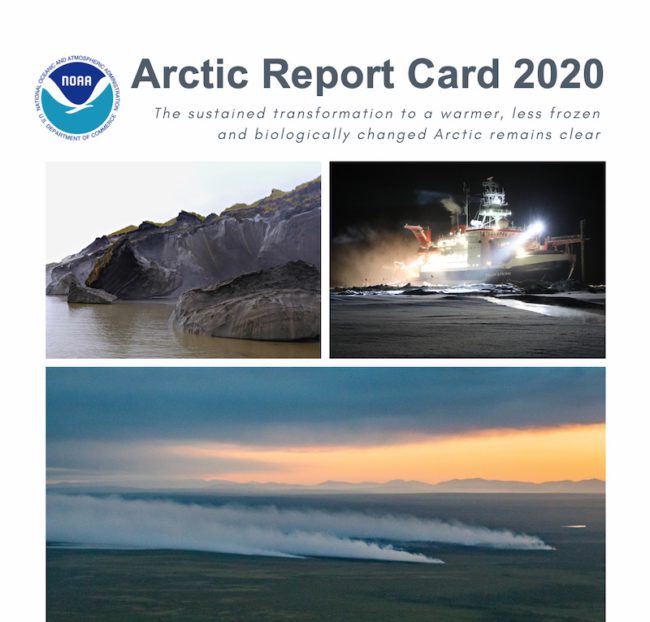
For those wondering what the Arctic Report Card is, permit me to explain. This NOAA Report Card is an annual volume of original, peer-reviewed environmental observations and analysis of a region undergoing rapid and dramatic change.
This latest update for 2020 was prepared by an international team of 134 researchers from 15 different countries and published on Dec 8.
Highlights for 2020
Oh come now, you know the story that is unfolding.
The full report is organised into three sections:
- Vital Signs provides annual updates on seven topics: Surface Air Temperature; Terrestrial Snow Cover; Greenland Ice Sheet; Sea Ice; Sea Surface Temperature; Arctic Ocean Primary Productivity; and Tundra Greenness.
- Other Indicators explore topics that are updated periodically.
- Frostbites reports on new and emerging issues, and topics that relate to long-term scientific observations in the Arctic.
Permit me to simply cut and paste from the highlights section that can be found here …
Highlights
- The average annual land surface air temperature north of 60° N for October 2019-September 2020 was the second highest on record since at least 1900. Record warm temperatures in the Eurasian Arctic were associated with extreme conditions in the ocean and on the land.
In the oceans
- Sea ice loss in spring 2020 was particularly early in the East Siberian Sea and Laptev Sea regions, setting new record lows in the Laptev Sea for June. The end of summer sea ice extent in 2020 was the second lowest in the 42-year satellite record, with 2012 being the record minimum year.
- August mean sea surface temperatures in 2020 were ~1-3°C warmer than the 1982-2010 August mean over most of the Arctic Ocean, with exceptionally warm temperatures in the Laptev and Kara seas that coincided with the early loss of sea ice in this region.
- During July and August 2020, regional ocean primary productivity in the Laptev Sea was ~2 times higher for July and ~6 times higher for August compared to their respective monthly averages.
- Bowhead whales have been a staple resource for coastal Indigenous peoples for millennia and are uniquely adapted for the arctic marine ecosystem. The Pacific Arctic population size has increased in the past 30 years likely due to increases in ocean primary production and northward transport of the zooplankton they feed on.
- Shifts in air temperatures, storminess, sea ice and ocean conditions have combined to increase coastal permafrost erosion rates, in regions where a high proportion of Arctic residents live and industrial, commercial, tourist and military activities are expanding.
On the land
- The exceptional warm spring air temperatures across Siberia resulted in record low June snow cover extent across the Eurasian Arctic, as observed in the past 54 years.
- Extreme wildfires in 2020 in the Sakha Republic of northern Russia coincided with unparalleled warm air temperatures and record snow loss in the region.
- Since 2016, tundra greenness trends have diverged strongly by continent, declining sharply in North America but remaining above the long-term average in Eurasia.
- From September 2019 to August 2020, the Greenland Ice Sheet experienced higher ice loss than the 1981-2010 average but substantially lower than the record 2018/19 loss.
- Glaciers and ice sheets outside of Greenland have continued a trend of significant ice loss, dominated largely by ice loss from Alaska and Arctic Canada.
Observing Arctic change
- Advancements in the integration of models and observations have increased the skill and utility of Arctic sea ice predictions on seasonal to decadal to century timescales.
- Important additions to the Arctic Observing Network (AON) systems and data products and advancements in process-level understanding have improved the quality and accessibility of information used to produce the Arctic Report Card.
- The unique Multidisciplinary drifting Observatory for the Study of Arctic Climate (MOSAiC) project concluded a historic, international, yearlong expedition into the Arctic ice pack in September 2020, collecting a legacy dataset that aims to advance the understanding, modeling and predicting of Arctic environmental change.
- Opening of the new NOAA Barrow Observatory, near Utqiaġvik, Alaska, enables the continuation of nearly half a century of atmosphere and terrestrial in situ observations.
Arctic Report Card – The Movie
They also articulate a good summary within this offial NOAA YouTube clip (just 4 mins) …
“The story is clear, the Arctic is warmer, less frozen, and transforming biologically …“
All the details
The full report, the entire PDF, can be found here. Be aware, this is not a small document.
A far more accessible format is via the online Home page … here.
You can actually get all the datasets … via here.
There is of course also a press release … here. Like most press releases, it has a few quotes …
“For 15 years, the Arctic Report Card has helped NOAA fulfill its mission of providing the scientific information our nation needs to better understand how climate change is affecting the Arctic and weather around the globe, Our ability to meet the challenges and opportunities of an Arctic region in transition depends on how well we can observe and predict the pace and scale of these changes.”
Navy Rear Adm. Timothy Gallaudet, Ph.D., deputy undersecretary of commerce for oceans and atmosphere at NOAA – he led the news conference
“Taken as a whole, the story is unambiguous, The transformation of the Arctic to a warmer, less frozen and biologically changed region is well underway.”
Rick Thoman, Alaska Climate Specialist with the International Arctic Research Center, and one of three editors of this year’s report card.
